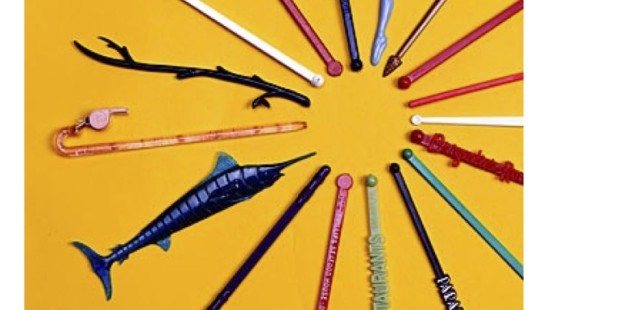By Stephen Visakay (with Maddy Lederman), Special to the Los Angeles Times, September 16, 2010. Photo: Ann Cusack/Los Angeles Times
There’s more history to these cocktail-stirring devices than Don Draper could imagine. They’re collectibles as well as connections to the past. “Mad Men,” the Emmy-winning cultural phenomenon, has sparked renewed interest in yet another quirky artifact from its era. In addition to slim suits, lunchtime cocktails and cigarettes, the 1960s mark the glory days in the history of the swizzle stick — and Don Draper’s Old-Fashioned would’ve been considered unfinished, even uncivilized, without one.
Today, these mini-pop-culture icons are emerging as entertaining and valued collectibles. Tangible connections to the past, they’re terrific conversation pieces and come in an infinite variety of dazzling shapes and colors.
The swizzle stick’s origin can be traced to its first appearance on sugar plantations in the West Indies in the 1600s as a small branch used to stir a refreshing rum elixir called “Switchel.” It seems we’ve never stopped using them. Queen Victoria was known to use a stirring rod to chase bubbles out of her Champagne, quietly avoiding any embarrassment from those pesky fizzy gasses.
The Gibson Girls and then flappers of the Roaring ’20s used swizzle sticks made of glass and newly invented Bakelite plastic.
They were already a hot item when all they did was stir. But it was inventor Jay Sindler who, in 1934, revolutionized swizzle sticks with an advertising idea that would equal any marketing ploy cooked up by Don Draper at Sterling Cooper. And like Don’s, his timing was perfect.
Two and a half months after the repeal of Prohibition, Sindler sat contemplating his martini at the bar in Boston’s Ritz Carlton Hotel, wondering how he could remove the olive without dipping his fingers into his gin. He sketched the solution to this problem on his cocktail napkin; it was a small spear made of wood with a paddle-shaped handle. The paddle would be used as a miniature billboard imprinted with the establishment’s name.
This idea would have been worthless during Prohibition when speak-easies hid from the law, but after repeal, drinking establishments wanted their names and addresses out in public. Swizzle sticks conveyed the information and were cheaper than a book of printed matches and cheaper still than the vanishing ashtrays that also boasted printed logos. Sindler was granted his patent on Feb. 19, 1935, and his invention and his company, Spir-it Inc., are still in business.
World War II and then the space race prompted growth in injection molding and plastic technologies that were good for the development of the swizzle. By the 1960s, we’d reached the golden age of the swizzle stick; any form was possible, fantasy designs were limited only by an artist’s imagination and a client’s request.
Swizzles became an important part of any lounge’s décor. They were snapped up as soon as they were set out, and the more exciting the design, the faster they were pocketed. As playful representations of their establishments, they became more whimsical and intricate — for example, sporting a lobster for a seafood restaurant or a steer for a steakhouse. Las Vegas casinos all competed to have the most extravagant swizzle in town.
Taking swizzles as a memento was assumed and encouraged. They were saved for years. They made customers feel like they were given a gift, and the cheap but magical memories on a stick beckoned them back to an establishment again and again. A Madison Avenue dream come true.
It wasn’t until the 1980s that swizzle sticks fell upon hard times. The rise of Jane Fonda workout videos and general health consciousness prompted a decline in cocktail consumption, bars and restaurants tightened their belts, and swizzle sticks practically disappeared. Remaining patrons were left with a flimsy red straw, hardly substantial enough to move the ice around their drink.
Thankfully, this didn’t go on forever.
In the late 1990s, a cocktail resurgence began with new appreciation for the martini. This trend was reinforced by four sexy city girls who downed more than a few Cosmos on HBO. And the green apple martini that did its part to spike interest is now thankfully gone, replaced by properly mixed classics.
Luckily, the swizzle stick lives on, most notably in New Orleans with the opening of the Swizzle Stick Bar, the Tales of the Cocktail yearly festival and the founding of the Museum of the American Cocktail by Dale DeGroff.
Marketing manager Rachel Pantely of Spirit Foodservice (formerly Jay Sindler’s Spir-it Inc.) says sales on custom designed/molded accessories are up almost 14% from last year.
The delightful swizzle stick is likely to remain popular in challenging economic times. Cocktails, a relatively inexpensive luxury, are all the more transporting when properly accessorized.
food@latimes.com
http://www.latimes.com/features/food/la-fo-swizzle-stick-20100916,0,6723869.story#ixzz2pcrjnoxT
